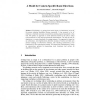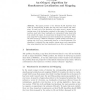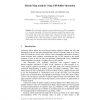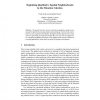95
Voted
SPATIALCOGNITION
2004
Springer
15 years 6 months ago
2004
Springer
Wayfinding, i.e. getting from some origin to a destination, is one of the prime everyday problems humans encounter. It has received a lot of attention in research and many (commerc...
91
Voted
SPATIALCOGNITION
2004
Springer
15 years 6 months ago
2004
Springer
Cities on a map that are directly connected by a route are judged closer than unconnected cities. This route effect has been attributed to memory distortions induced by the integra...
112
Voted
SPATIALCOGNITION
2004
Springer
15 years 6 months ago
2004
Springer
Allen’s interval calculus is one of the most prominent formalisms in the domain of qualitative spatial and temporal reasoning. Applications of this calculus, however, are restric...
97
Voted
SPATIALCOGNITION
2004
Springer
15 years 6 months ago
2004
Springer
This paper presents results from a desktop experiment in which the participants’ route selection behavior in an unknown street network is investigated. The participants were pres...
82
Voted
SPATIALCOGNITION
2004
Springer
15 years 6 months ago
2004
Springer
Diagrams are an effective means of conveying concrete, abstract or symbolic information about systems. Here, individuals or pairs of participants produced assembly instructions aft...
99
Voted
SPATIALCOGNITION
2004
Springer
15 years 6 months ago
2004
Springer
Two experiments are presented studying interrelations between spatial properties of environments and both experience and spatial behavior. In order to systematically study such int...
110
Voted
SPATIALCOGNITION
2004
Springer
15 years 6 months ago
2004
Springer
This paper presents a very efficient SLAM algorithm that works by hierarchically dividing the map into local regions and subregions. At each level of the hierarchy each region stor...
94
Voted
SPATIALCOGNITION
2004
Springer
15 years 6 months ago
2004
Springer
We developed a method to analyze sketch maps by GIS, and applied it to an actual case study. We found that analysis using buffer operation was more effective for sketch map analyse...
99
Voted
SPATIALCOGNITION
2004
Springer
15 years 6 months ago
2004
Springer
Abstract. We present first ideas on how results about qualitative spatial reasoning can be exploited in reasoning about action and change. Current work concentrates on a line segm...
93
Voted
SPATIALCOGNITION
2004
Springer
15 years 6 months ago
2004
Springer
This paper gives the SNAP and SPAN ontologies relating to recognizing variable vista spatial environments, namely, SNAPVis and SPANVis. It proposes that recognizing spatial environ...




